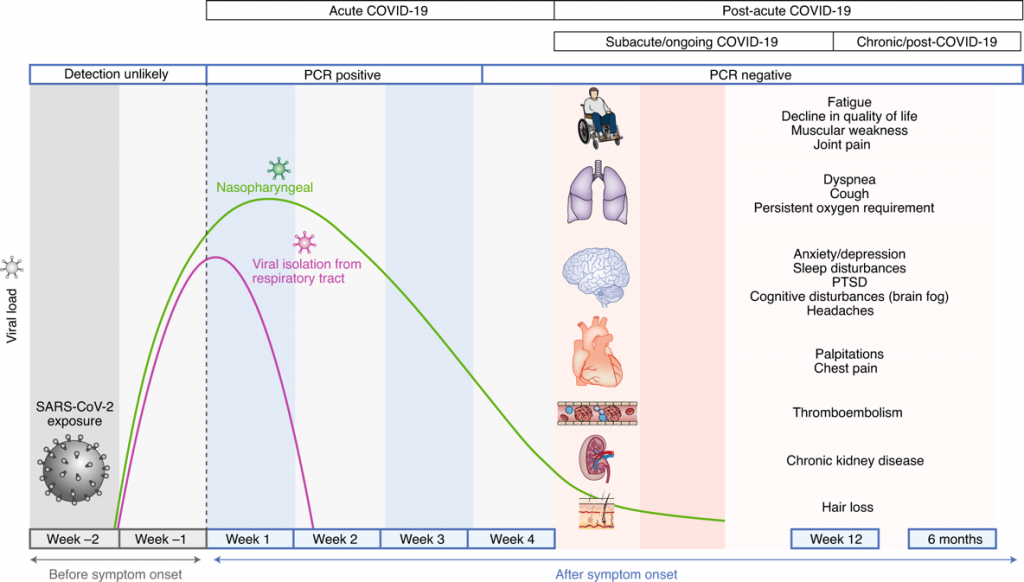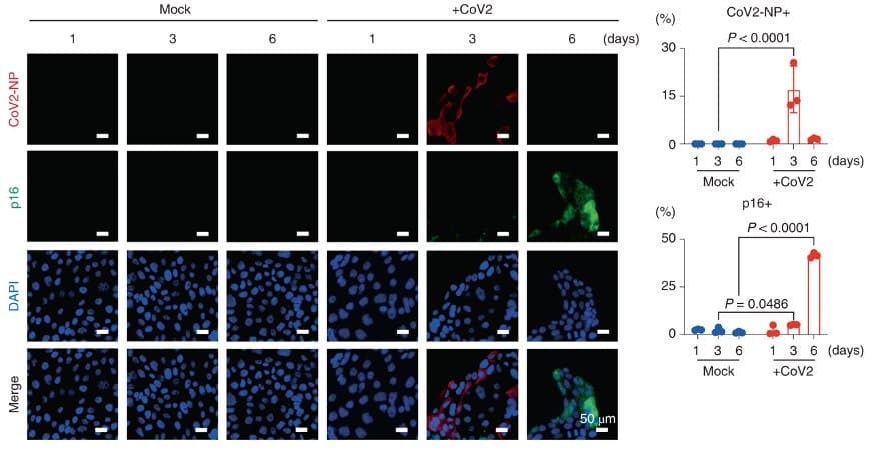Highlights
- Human lung cells are transformed into senescent “zombie cells” by SARS-CoV-2.
- Drugs called senolytics can eliminate these once infected lung cells that have become senescent.
- Coronavirus may accelerate aspects of aging by induction of senescent lung cells.
Coronavirus (SARS-CoV-2) just doesn’t seem to go away, and even when it does, it continues to cause problems. In what’s called post-acute COVID-19 syndrome, COVID-19 survivors who test negative for the virus weeks after infection still have symptoms, many of which are related to inflammation. How do these symptoms persist even after the virus is gone?
According to a study by Tsuji and colleagues from Osaka University in Japan, in an article published in Nature Aging, coronavirus may induce inflammation-generating senescent cells – zombie-like cells that accumulate with age. As part of their study, the researchers found that a drug called ABT-263 eliminates senescent cells and reduces inflammation, making it a potential therapy for post-acute COVID-19 syndrome. The study explains why aged individuals might be more susceptible to COVID-19 by revealing the relationship between coronavirus and senescent cells.

(Nalbandian et al., 2021 | Nature Medicine) Post-Acute COVID-19 Syndrome. This represents a group of symptoms that persist in patients after acute COVID-19 infection (after about four weeks), affecting multiple organ systems. Because post-acute COVID-19 syndrome patients test negative for the virus, the direct cause of persistent symptoms is unknown but may be related to inflammation.
Coronavirus Transforms Lung Cells into Senescent Cells
Senescent cells are like zombie cells, neither fully alive nor dead. These growth-arrested cells accumulate with age and secrete proinflammatory molecules, contributing to age-related diseases. Since inflammation is a symptom of post-acute COVID-19 syndrome, Tsuji and colleagues tested whether coronavirus induced senescence in lung cells, triggering inflammation.
The Japanese scientists determined that human lung cells infected with coronavirus secrete a molecule (TNFɑ) that leads to the senescence of surrounding non-infected cells in a dish. This told the researchers that coronavirus transforms lung cells that are not infected. They next took the airway lining from human lungs (human bronchial organoids), put them into a dish, and exposed them to coronavirus. After the infection was gone, the lung cells appeared in a senescent state, verifying the results in a more accurate human lung tissue model.

(Tsuji et al., 2022 | Nature Aging) Senescent Cells Detected After Coronavirus Infection. Multiple cell types lining human lung airways were grown in a dish and exposed to coronavirus (+Cov2). As opposed to uninfected cells (mock), SARS-CoV-2 was detected (red, [CoV2-NP]) after day 3 in the exposed cells and was gone by day 6. Senescent cells – labeled by p16 (green) – were detected only on day 6 in the coronavirus exposed cells. DAPI (blue) shows the nucleus of each cell.
Senescent Cells Detected in Lungs of COVID-19 Patients
To see if the coronavirus induces senescence in people infected with coronavirus, the Osaka University scientists examined lung tissue from patients with severe post-acute COVID-19 syndrome. As expected, the tissue showed no signs of COVID-19, indicating that the coronavirus infection had subsided. Like the lung cells in a dish, signs of senescent cells and inflammation were found in the COVID-19 patient tissue. Since inflammation is associated with post-acute COVID-19 syndrome, the authors state:
“It is tempting to speculate that the senescence-like [characteristics] induced by SARS-CoV-2 infection may be involved in the development of post-acute COVID-19 syndrome.”
Treating Coronavirus Induced Senescence with Senolytics
Senolytics are drugs that destroy senescent cells, eliminating their potential to cause inflammation. So, if the inflammation caused by coronavirus infection results from senescence, senolytic drugs will reduce inflammation and treat the symptoms of post-acute COVID-19 syndrome. To explore this possibility, Tsuji and colleagues treated coronavirus-infected mice with senolytic drugs.
Mice cannot be infected by the coronavirus that infects humans, so the researchers used a mouse version of the coronavirus (SARS-CoV-2 MA10). Like in human lung cells, the mouse coronavirus transformed the mouse lung cells into senescent lung cells. Furthermore, treatment with the senolytic drug ABT-263 reversed the senescent state, indicating that senolytic drugs could clear out the coronavirus-induced senescent cells.

Senolytics for Treating Post-Acute COVID-19 Syndrome?
Tsuji and colleagues showed that coronavirus induces senescence in human lung cells, which can be treated with senolytic drugs in mice. This gives rise to the possibility that senolytic drugs could be used to clear senescent cells in patients with post-acute COVID-19 syndrome, potentially alleviating inflammation-related symptoms. But are senolytics the answer?
Several animal studies have had promising results, but others have not. In one study, eliminating senescent cells reduced mortality in mice infected with mouse hepatitis virus, a virus in the same family as coronavirus. In another study, senescent cells were eliminated in COVID-19 infected Syrian hamsters using senolytic drugs. However, a recent study has shown that removing senescent cells results in severe liver dysfunction in mice. Therefore, it seems that more research is needed to confirm the safety of using senolytic drugs.
Can Coronavirus Accelerate Aging?
Based on Tsuji and colleagues’ study, coronavirus induces senescence in non-aged cells. These inflammation-generating senescent cells are hypothesized to contribute to the symptoms of post-acute COVID-19 syndrome. Interestingly, many of the post-acute COVID-19 symptoms are similar to the symptoms of aging. These include hair loss, diabetic ketoacidosis, acute kidney injury, headaches possibly due to inflammation of the arteries, and venous thromboembolism. Another symptom is inflammation of the heart, which may lead to several types of heart disease in the elderly. It would therefore seem as if coronavirus jump-starts aspects of aging.
Our understanding of aging and post-acute COVID-19 syndrome are incomplete, but both conditions appear to interact since older people are often hit harder by the coronavirus infection. This may be due to the induction of more senescent cells, which are already greater in number in older individuals, creating a compound inflammatory effect. However, only a few animal studies show that coronavirus leads to senescence. Regardless, it certainly seems possible that viruses like coronavirus can induce senescence in human cells, which through inflammation, could accelerate the occurrence of cellular damage, leading to organ dysfunction and diseases similar to those that occur with aging.